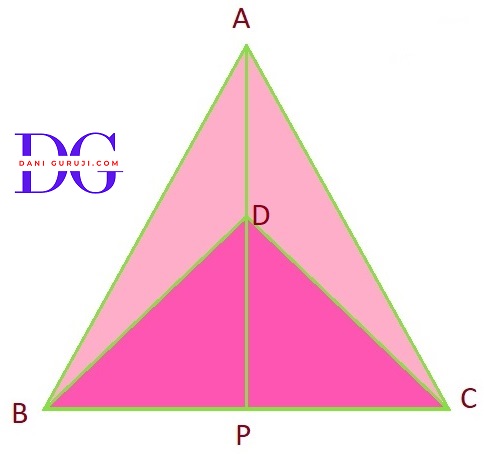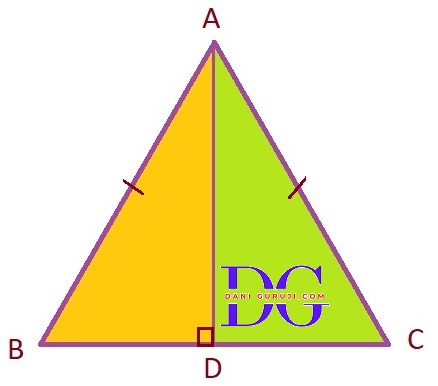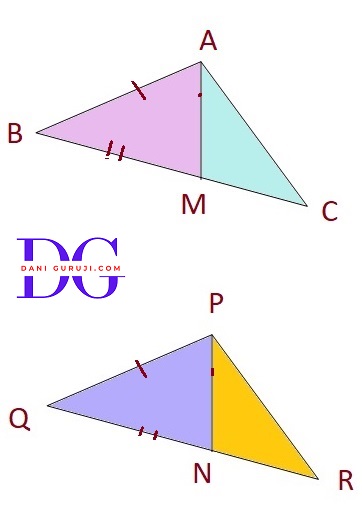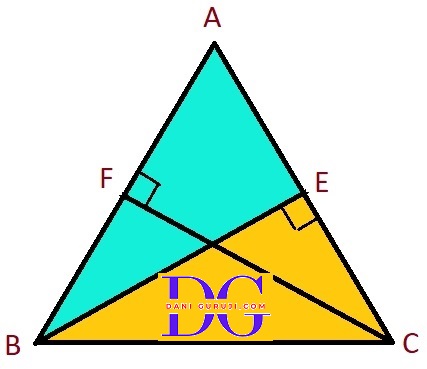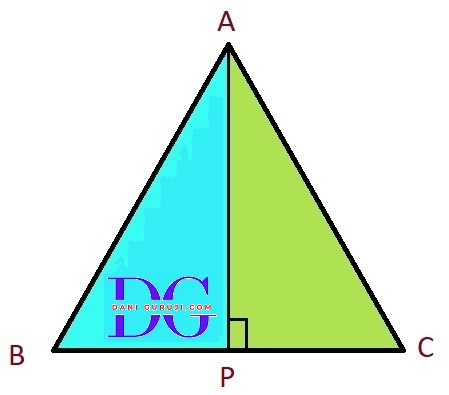ΔABC and ΔDBC are two isosceles triangles on the same base BC and vertices A and D are on the same side of BC (see Fig.). If AD is extended to intersect BC at P, show that
(i) Δ ABD $\cong$ Δ ACD
(ii) Δ ABP $\cong$ Δ ACP
(iii) AP bisects $\angle $A as well as $\angle $D.
(iv) AP is the perpendicular bisector of BC.
Solution :
Part (i): Δ ABD $\cong$ Δ ACD
We are given that Δ ABC and Δ DBC are isosceles triangles on the same base BC, with vertices A and D on the same side of BC.
Therefore, in Δ ABC, AB = AC
And in Δ DBC, DB = DC
Consider the Δ ABD and Δ ACD:
⇒ AB = AC
( Given, Equal sides of isosceles Δ ABC )
⇒ DB = DC
( Given, Equal sides of isosceles Δ DBC )
AD = AD
( This is a common side for both triangles.)
∴ Δ ABD $\cong$ Δ ACD
( by the SSS congruence rule. )
Part (ii): Δ ABP $\cong$ Δ ACP
In part (i), we know that Δ ABD $\cong$ Δ ACD
This means that corresponding parts of congruent triangles are equal (CPCT).
Therefore, $\angle $BAD = $\angle $CAD.
Consider the Δ ABP and Δ ACP:
⇒ AB = AC
( Given, Equal sides of isosceles Δ ABC )
⇒ $\angle $BAP = $\angle $CAP
( Since $\angle $BAD = $\angle $CAD, and P is on the extension of AD, we can write $\angle $BAP = $\angle $CAP )
AP = AP
( This is a common side for both triangles.)
∴ Δ ABP $\cong$ Δ ACP
( by the SAS congruence rule. )
Part (iii): AP bisects $\angle $A as well as $\angle $D
In part (i), we know that Δ ABD $\cong$ Δ ACD
This means that corresponding parts of congruent triangles are equal (CPCT).
Therefore, $\angle $BAD = $\angle $CAD.
Since P lies on the extension of AD, this means that line segment AP bisects $\angle $A
From the congruence in part (i), we also know that corresponding angles are equal.
Therefore, $\angle $ADB = $\angle $ADC.
This means that line segment AD bisects $\angle $D.
Since P lies on the extension of AD, we can say that
AP bisects $\angle $A as well as $\angle $D.
Part (iv) AP is the perpendicular bisector of BC
In part (ii), we know that Δ ABP $\cong$ Δ ACP
This means that corresponding parts of congruent triangles are equal (CPCT).
Therefore, BP = CP
and $\angle $APB = $\angle $APC.
Since $\angle $APB and $\angle $APC are a linear pair, their sum is 180°
$\angle $APB + $\angle $APC = 180°
2 $\angle $APB = $ { 180° }$
$\angle $APB = $ { 180° \over 2}$
$\angle $APB = $ { 90° }$ = $\angle $APC
This means that AP is perpendicular to BC
Also, we established that BP = CP. This means that P is the midpoint of BC, so AP bisects BC
Since AP is both perpendicular to BC and bisects BC, we can conclude that AP is the perpendicular bisector of BC.
AD is an altitude of an isosceles triangle ABC in which AB = AC. Show that
(i) AD bisects BC
(ii) AD bisects $\angle $A
Solution :
(i) AD bisects BC
We are given that Δ ABC is an isosceles triangle with AB = AC, and AD is an altitude to BC.
This means that AD is perpendicular to BC,
So,$\angle $ ADB = $\angle $ ADC = 90°
Consider the Δ ABD and Δ ACD:
⇒ AB = AC
( Given, Equal hypotenuse of a right-angled triangle )
⇒ $\angle $ ADB = $\angle $ ADC = 90°
( Given, since AD is an altitude )
AD = AD
( This is a common side for both triangles.)
∴ Δ ABD $\cong$ Δ ACD
( by the RHS congruence rule. )
This means that corresponding parts of congruent triangles are equal (CPCT).
Therefore, BD = CD.
This shows that D is the midpoint of BC, and thus, AD bisects BC.
Part (ii) AD bisects $\angle $A
In part (i), we know that Δ ABD $\cong$ Δ ACD
This means that corresponding parts of congruent triangles are equal (CPCT).
Therefore, $\angle $BAD = $\angle $CAD.
This equality of angles means that AD divides $\angle $A into two equal parts, thus AD bisects $\angle A $ .
Two sides AB and BC and median AM of one triangle ABC are respectively equal to sides PQ and QR and median PN of Δ PQR. Show that :
(i) Δ ABM $\cong$ Δ PQN
(ii)Δ ABC $\cong$ Δ PQR
Solution :
We are given that Δ ABC and △ PQR, where AB = PQ, BC = QR and median AM = PN .
AM is the median of △ ABC
∴ BM = CM = ${1 \over 2}$ BC
Also, PN is the median of △ PQR
∴ QN = RN = ${1 \over 2}$ QR
Since we are given that BC = QR,
we can conclude that ${1 \over 2}$BC = ${1 \over 2}$QR , which means BM = QN.
(i) Δ ABM $\cong$ Δ PQN
Consider the Δ ABM and Δ PQN:
⇒ AB = PQ
( Given,)
⇒ AM = PN
( Given, )
⇒ BM = QN
( This is proved above.)
∴ Δ ABM $\cong$ Δ PQN
( by the SSS congruence rule. )
Since we have proved that Δ ABM $\cong$ Δ PQN
This means that corresponding parts of congruent triangles are equal (CPCT).
Therefore, $\angle $B = $\angle $Q.
(ii) Δ ABC $\cong$ Δ PQR
Consider the Δ ABC and Δ PQR:
⇒ AB = PQ
( Given,)
⇒ BC = QR
( Given, )
⇒ $\angle $B = $\angle $Q
( This is proved above.)
∴ Δ ABC $\cong$ Δ PQR
( by the SAS congruence rule. )
BE and CF are two equal altitudes of a triangle ABC. Using RHS congruence rule, prove that the triangle ABC is isosceles.
Solution :
From given figure, It is given that
Altitudes, BE = CF,
CF is an altitude to side AB, which means = $\angle $AFC = $\angle $BFC = 90°
BE is an altitude to side AC, which means = $\angle $ AEB = $\angle $ BEC = 90°
Consider the two right-angled triangles ΔBEC and Δ CFB
⇒ BE = CF
( Given that the altitudes are equal. )
⇒ $\angle $ BEC = $\angle $ BFC
( Both are 90°. )
⇒ BC = BC
( Since this hypotenuse side is common to both triangles, )
∴ ΔBEC $\cong$ Δ CFB
( by the RHS congruence rule. )
Since the two triangles are congruent, their corresponding parts are also equal (CPCT). Therefore, the angles opposite the equal sides must be equal.
Since BE = CF and the triangles are congruent, the angles opposite to these sides must be equal.
So, $\angle $FCB = $\angle $EBC, which means $\angle $C = $\angle $B.
Since the base angles of △ABC are equal ( $\angle $C = $\angle $B), the sides opposite to these angles must also be equal. This means AB = AC.
A triangle with two equal sides is an isosceles triangle. Therefore, △ABC is an isosceles triangle.
ABC is an isosceles triangle with AB = AC. Draw AP ⊥ BC to show that $\angle $B = $\angle $C.
Solution :
From given figure, It is given that
AP is the perpendicular of BC. This means that
$\angle $APB = $\angle $APC = 90°
And AB = AC.
Consider the triangles Δ APB and Δ APC
⇒ AB = AC
( Given,Equal hypotenuse of a right-angled triangle. )
⇒ $\angle $APB = $\angle $APC
( Both are 90°. )
⇒ AP = AP
( Common side to both triangles. )
∴ Δ APB $\cong$ Δ APC
( by the RHS congruence rule. )
Since the two triangles are congruent, their corresponding parts must be equal
$\angle $B = $\angle $C. (By C.P.C.T.)
By definition, a triangle with two equal sides is an isosceles triangle. Since we have shown that
Therefore, $\angle $B = $\angle $C. This proves that the base angles of an isosceles triangle are equal..
Syllabus for class 10
Advanced courses and exam preparation.
Previous Year Paper
Advanced courses and exam preparation.
Mock Test
Explore programming, data science, and AI.
